Rapid Progress on Busy Main Lines
RAILWAYS OF EUROPE - 16
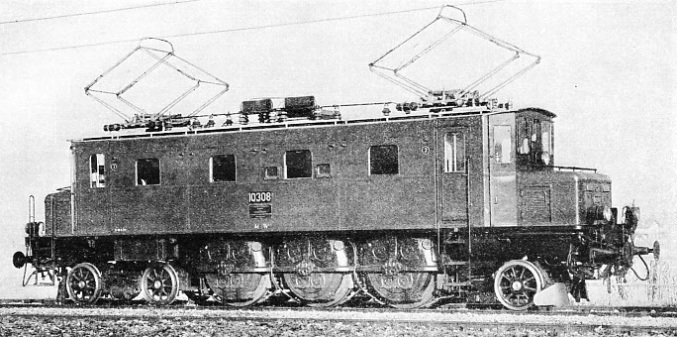
A 2-Co-1 TYPE electric locomotive built by the famous firm of electrical engineers, Brown-Boveri, for service on the lines of the Swiss Federal Railways. The individual axles are clearly shown.
WHILE it is generally agreed today that electrification is the best way of handling suburban railway traffic around large cities, the great progress which the electrification of main-line railways is making on the continent of Europe may come as a surprise to many people interested in railways. Ever since the war of 1914-18 each year has seen a considerable addition to the electric route-mileage of long-distance Continental railways, but 1934 witnessed a decided acceleration. In that year plans were laid for and work started on projects which will, between 1937 and 1940, result in nearly 20,000 route miles of main-line track being worked by electric locomotives or by electric motor-coach trains.
Some years ago Professor Reichel, the well-known German railway engineer, stated that by 1937 it might be possible to travel from Berlin to Rome on electrified tracks. The plans drawn up in 1934 brought the realization of this prophecy a big step nearer, as might be expected.
The Italian Government in 1934 announced its intention of electrifying the lines from Rome to Pisa, along the coastal route, and from Rome to Florence. The Florence-Bologna Direttissima, described in the chapter, “The Great Apennine Tunnel”, is one of the electrified links between Rome and the Swiss frontier. The electric line up from Bolzano to Brennero is another. Travel across Austria is now electric, also from the German-Austrian frontier to Augsburg and Regensburg. The line between Augsburg and Niirnberg is now being electrified. The German Government has recently announced its intention of electrifying the tracks between Berlin and Nurnberg. There is already a large electrified railway network in Central Germany.
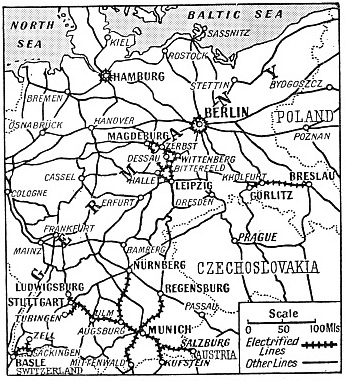
1,300 ROUTE MILES of line have so far been electrified by the German State Railways. Eighty-five per cent are on the single phase system. The Central German electrification plan is chiefly inter-urban; converted sections are as yet unconnected.
At the time of writing the longest continuous electrically operated journey possible in Europe is over the 529 miles from Geneva to Salzburg via Zurich and Innsbruck by the Swiss Federal and Austrian Federal Railways. The distance is a little more than that from London to Aberdeen by the East Coast Route.
By 1937 it is hoped that electrical operation will be continuous from Paris for 512 miles to the Spanish frontier at Irun. The distance of 219 miles from St. Pierre-des-Corps (Tours) to Bordeaux, at present steam-worked, still remains to be electrically equipped. At a later date the other main line of the Paris-Orleans-Midi, now electrified from Paris for 313 miles to Brive, will also be electrically worked through to Port Bou, on the Spanish border, 605 miles from Paris.
Another important long-distance route is that from Stockholm to Malmo, the Swedish port offering the main connexion with the Continent. From Stockholm to Gothenburg (Goteborg) the journey used to take eight hours forty minutes; to-day it takes only a little over six hours.
It may be asked why 1934, a year of unstable political and trading conditions, was the time of such renewed activity in main-line electrification. The usual answer is that, whatever may have been the principal reasons for undertaking electrification, the success of the existing electrified railways has shown that electrification pays, through lowering operating costs and attracting new traffic to the railway, even when pre-conversion traffic density is comparatively low. The Southern Railway’s schemes in Great Britain are a striking example of this. While on some sections of the Southern Railway lines the traffic densities are the highest in the world, rising to 3,000,000 train miles per route mile per year, the company has found it economic to electrify sections in Sussex such as those from Keymer to Lewes, Lewes to Seaford, and Hastings to Eastbourne, along which there were, with steam working, only a few trains an hour in either direction.
In part, also, intensive railway electrification has been induced by the favourable effect of railway electrification work on unemployment. The German Government has estimated that eighty per cent of the cost of the conversion of the Munich-Stuttgart main line went in wages, and, assuming a high average wage, the total employment likely to be given to German labour in railway schemes envisaged for the next thirty years would be 1,460,000 men-years.
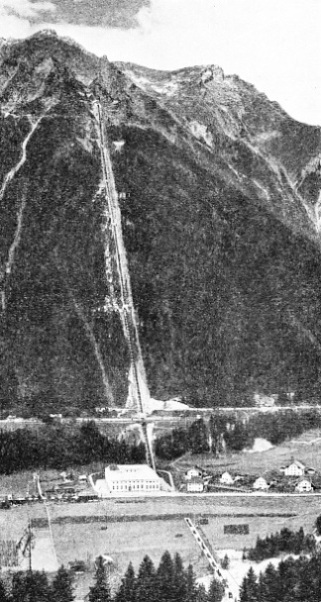
A GENERAL VIEW of the power station at Spullersee, near Bludenz, showing the giant pipes carrying water down the mountain-side. This power-house was recently built in connexion with the big railway electrification schemes in Austria.
Railway electrification brings prosperity also to the electrical and allied industries. Industries directly affected are the iron and steel industries, the cement and concrete undertakings, as well as the paper and cotton mills feeding the cable manufacturing companies, and the china-clay and glass producers. No scheme of railway electrification, however, has been, or ever will be, put into operation with these ends primarily in view. Electrification is decided solely on its merits as a method of railway working. But these extraneous considerations have some bearing upon the time when a scheme is finally sanctioned, and so may partly explain the great advance registered in 1934.
Although by 1940 the percentage of electrified route miles in Europe will be relatively small, it should be realized that the lines electrified are among the most densely loaded lines. The electrified railways linking Rotterdam, Amsterdam, and The Hague handle a very high percentage of the total traffic in Holland. In Austria the lines connecting Vienna with the frontiers are those which are electrically worked; while in Hungary the Budapest-Heygeshalom line is by far the most important of the railway arteries of Hungary. In Greece, the short Greek Electric Railway, with its headquarters in Athens, is the only railway with a high traffic density in that country. In Spain the many short stretches of line are all high-density traffic lines, and in Sweden the forty-six per cent of the railway mileage which has been electrified handles no less than eighty-three per cent of the railway traffic of the country. In Belgium, too, the first large electrification scheme is on the most important traffic artery - Brussels to Antwerp. Since this Brussels-Antwerp electrification is one of the most recent it is worth examining in some detail.
Only two of the four tracks between Brussels (Nord) and Antwerp (Central) have been electrified; these tracks have been reserved for fast non-stopping traffic, including the boat-train services for Antwerp Quay. The length of the line is about 27·7 miles, the maximum gradient is 1 in in, and the radius of the sharpest curve is 870 yards. As with the majority of Continental mainline electrification, it is carried out on the overhead system. Current is used at 3,000 volts, a voltage commonly adopted, although on the French railways 1,500 volts is nearly standard.
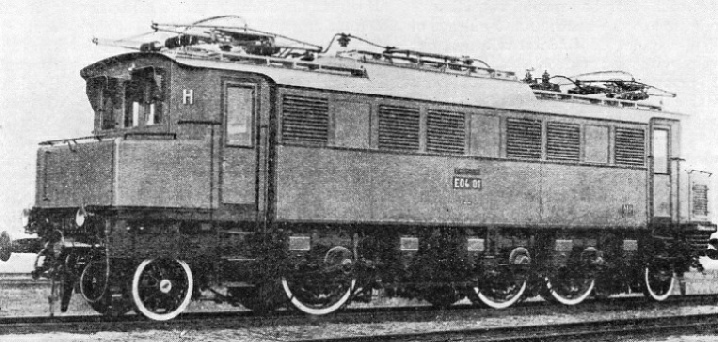
ONE OF THE WORLD’S FASTEST ELECTRIC LOCOMOTIVES. This E04 class locomotive, hauling a train of seven corridor coaches, attained a speed of 94 miles an hour on its test run. The engine was built by the Allgemeine Elektrische Gesellschaft for the German State Railways. The Reichsbahn have over 930 electric locomotives in operation.
The sub-stations, of which there are-two, are at present manually controlled, although arrangements have been made for conversion to automatic operation in the future. Each sub-station contains three air-cooled transformers and three mercury-arc rectifiers. The two sub-stations work in parallel, each supplying its own section of the track. Approximately 1,500 pylons are used along the line, the majority being of steel, although some are of concrete. The rolling-stock is of the most modern kind, being air-conditioned throughout. The air can be changed fifteen times an hour if necessary. In winter hot air is supplied, warmed by resistances placed beneath the underframe, and withdrawn through ducts under the seats. In summer the process is reversed and cold air is supplied. The carriages contain centre and end doors, pneumatically operated and controlled; they are opened by the driver and closed by the guard. The total laden weight of a four-coaches multiple-unit train is 250 metric tons (246 tons), including 116 second and 243 third-class passengers. The coaches are of all-steel construction with automatic couplings and roller bearings on the bogie axles. A trailer coach weighs about forty-four tons and a motor coach about seventy tons.
The motor coaches, of which there are two to each train working on the multiple-unit system, contain four 205 hp motors. A “dead-man’s handle” is incorporated in the control equipment, and air for the Westinghouse brakes is supplied by two compressors driven by 3,000-volt 10 hp motors.
The new service consists of sixty-seven trains a day in either direction, of which approximately half make a one-minute stop at Malines. The non-stop time between termini is thirty minutes, giving an average speed of about 55 mph. The stopping trains have an overall schedule of thirty-three minutes. Incidentally, it is worth noticing that this main-line scheme has been given precedence over the Brussels suburban lines.
The importance of railway electrification in Sweden can be gauged by the fact - already stated - that eighty-three per cent of the country’s railway traffic is handled on electric tracks. One of the most interesting lines is the Ore Railway in the north; there electrification has increased the carrying capacity of the line by fifty per cent, and has doubled the average speed, and has therefore made unnecessary the doubling of the line. This Ore Railway is united with the Norwegian port of Narvik. On the route from Lulea to the Norwegian coast most of the line is within the Arctic Circle. Extremely severe weather cond-itions are met with, and this has imposed on the equipment a heavy strain, which has been borne successfully.
The map indicates the extent of the Swedish State Railways schemes. An important factor behind electrification was the increase in the speed of travel to the Continent via Malmo. To the student of railway economics the Swedish State Railways scheme is of special interest. When the plans were laid in 1920 for the electrification of the first 310 miles, the price of
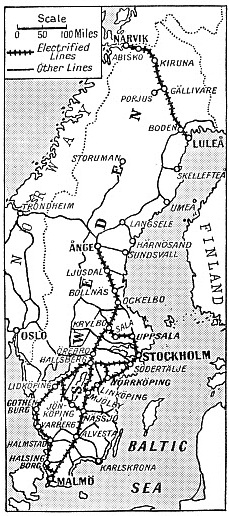
SWEDEN’S ELECTRIFIED LINES have proved of great value to the country. Eighty-three per cent of the Swedish rail traffic is handled on electric tracks. The total mileage electrified is over 1,000 and this map shows the extent of the power-operated lines.
The map indicates the extent of the Swedish State Railways schemes. An important factor behind electrification was the increase in the speed of travel to the Continent via Malmo. To the student of railway economics the Swedish State Railways scheme is of special interest. When the plans were laid in 1920 for the electrification of the first 310 miles, the price of imported locomotive coal was over £6 per ton. This high cost of coal constituted the basic reason for electrification. The experts consulted by the Swedish Government agreed that the price of coal would probably fall to about £2 15s. per ton. In 1930 and 1931 the price fell to between 16s. and £1. Nevertheless, because of the success of the existing electrified section in attracting traffic and lowering operating costs, an extension of a further 560 route miles was put in hand in 1932. In general the railway electrification schemes have proved of the greatest possible value to Sweden in the stimulation of employment and the virtual avoidance of the effects of industrial depression on the railways.
The Ore Railway is run on a single-phase supply from a specially constructed generating station at Porjus, which contains four 10,000 kVA single-phase generators. Power for the Swedish State Railways is taken from the three-phase general supply network. The catenary line is run at 16,000 volts 16⅔ cycles. The trolley wire and catenary cable of copper are 80 mm2 and 50 mm2 respectively. The lines are kept under constant mechanical tension by means of weights. At the top of the poles there are two 30 mm2 copper wires transmitting 10,000-volts single-phase power at 50 cycles for lighting and other purposes.
After much discussion it was decided that one type of locomotive should be used for all purposes on the Swedish State Railways. This decision, of course, has helped to reduce operating costs. The locomotive has three driving axles, one guiding axle, and motors totalling 1,600 horsepower. In changing from express to freight traffic, a differential reduction gear is used between the driving motors and jack-shaft. The express locomotives haul a train weighing 550 tons at a maximum speed of 65 mph. The freight trains, exclusive of the locomotive, weigh up to 900 tons, and are hauled at a maximum speed of 45 mph.
Apart from the line to Narvik from the Swedish frontier, the only important railway electrification scheme in Norway is that of the Oslo suburban railway system. But the State Railways have recently decided upon a number of short-distance conversion schemes, totalling about ninety-three route miles. Although the electrified lines of the State Railways amount to only six per cent of the whole railway system, the volume of traffic which they carry is as much as twenty-five per cent of the total traffic on the Norwegian railways.
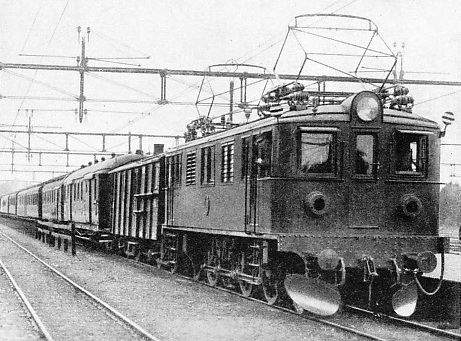
TO REDUCE OPERATING COSTS one type of electric locomotive is used throughout on the Swedish State Lines. The engine possesses three driving axles, one guiding axle, and motors totalling 1,600 horse-power. To adapt the locomotive for freight traffic from express service, a differential reduction gear is used between the driving motors and jack-shaft. The locomotives can haul expresses of over 500 tons at a maximum speed of 65 miles an hour.
In Denmark electrification has been confined to the Copenhagen suburban area. The first part of the electrification scheme was finished in 1934, and this has proved so successful that an extension is now nearly completed. A British firm has been responsible for all the control and traction equipment of the first scheme and is supplying control equipment for the extension, as well as the designs and specifications for the traction motors, which are being made in Denmark.
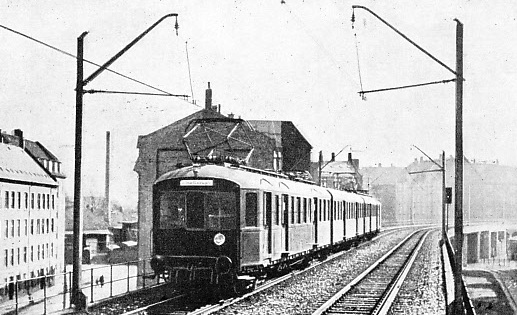
ON ELEVATED TRACK. An electric train entering Norrebro from Varlose in the direction of Helierup, on the Copenhagen suburban lines of the Danish State Railways.
Apart from a few small electrification schemes on privately owned railways, the German Reichsbahn (State Railways) electrification schemes fall into six as yet unconnected sections. The electrified mileage of these sections amounts to about 1,300 route miles, of which eighty-five per cent are on the single-phase system. In the north are the Hamburg and the Berlin suburban electrification schemes. At Hamburg power is drawn from the Altona power station, the oldest of the Reich-sbahn’s many power stations. For the Berlin railways power is taken partly from the Berlin Electricity Works - whose Charlottenburg power station, with its enormous steam accumulators, is one of the principal engineering “sights” of Berlin - and partly from Electrowerke Company in the central German brown coal area.
The central German electrification scheme of the Reichsbahn is essentially an inter-urban electrification scheme, the most recently electrified tracks being the fifty-four miles double-track section between Halle and Magdeburg. The electrification of these lines was undertaken because of the heavy existing traffic and because cheap power was available from the Muldenstein power station, which works on brown coal. This brown coal is not suitable for burning in locomotive boilers.
In the Silesian area very severe gradients are to be met with; on the Hirschberg-Stirchen section, for instance, there is a gradient of 1 in 40 for fifteen miles, and between the towns of Breslau and Gorlitz there is a 1 in 50 gradient. There are very heavy gradients, too, on the largest of the German electrified sections - that of Bavaria-Wiirttemberg. On the line between Augsburg and Stuttgart, the electrification of which was completed in 1933, there is a gradient of 1 in 44 for four miles, which is taken by electric trains at 42 mph. On the electrified Freilassing-Berchtesgaden line there is a three-miles gradient of 1 in 25. Energy is supplied to the Bavarian section from the Bavarian State power stations linked up with the general industrial electricity supply system for the area. A most important extension of the Bavarian electrified lines is being carried out, at the time of writing, from Augsburg to Nurnberg.
The Baden electrified section is supplied by water-power stations in the Black Forest, which, in conjunction with steam stations, form a natural grid system. On this line were first used the rectifier locomotives designed by Professor Reichel. On the rectifier locomotive the conversion from alternating current to direct current is carried out not in the railway sub-station but in the locomotive itself, which is fitted with a special type of rectifier equipment. On the Baden line the feeders are supplied with three-phase current at 50 cycles, split up into its phases, and converted to DC in the locomotive. This has enabled the Baden railway network to obtain supply cheaply from a number of industrial power stations.
The Reichsbahn had altogether about 937 electric locomotives at the end of 1934. The record speed reached at the end of that year was 94 mph with a train-load of 309 tons.
The two European countries with the largest amount of total railway track converted to electrical operation are Italy and Switzerland. In Switzerland all the main lines and the great majority of the branch lines are electrically worked. Over ninety per cent of the country’s traffic is now operated in this way. Long, continuous gradients of 1 in 37 to 1 in 40 are common on the main lines. The latest locomotives are capable of hauling 600-tons trains up these inclines, as has been shown in the chapters on the St. Gothard and Lotschberg Railways, beginning respectively on pages 139 and 1065. Italy and Austria also receive adequate treatment in other chapters of this work.
After Italy and Switzerland, France contains the most important main-line electrification schemes in Europe. Railway electrification in France since the war has made consistent progress, due in part to a desire to reduce the importation of coal. France’s coalfields are situated in the north and east, and are by no means adequate to the demands of industry, still less of the railways. At the same time there are enormous developed and undeveloped water power resources in the Alps, the Pyrenees, and the mountainous region known as the Massif Central.
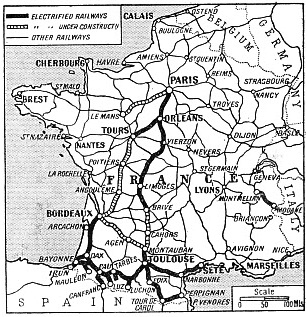
THE ELECTRIFIED ROUTES OF FRANCE are shown on this map. A desire to reduce the importation of coal and to develop the water power resources has led to large electrification schemes since the war of 1914-1918, especially in the neighbourhood of the Pyrenees.
Early in the present century the water resources of the Pyrenees were developed for supplying the electrochemical industry, and the Midi Railway Company seized on the advantage of cheap power to begin its extensive schemes. The Pyrenees region gives an excellent example of the benefits which may be derived from the joint development of electrified industry, agriculture, and railway traction. To-day the company owns seven power stations in the Pyrenees, only half the load of these stations being normally used for traction, the other half supplying cheap current to the region.
The electrification of the Paris-Orleans Railway, now amalgamated with the Midi Line, has also been connected with the development of power supply in the national interest. The growth of Paris has outstripped the capacity of its large and highly efficient steam-power stations, and to-day much of the electricity in Paris comes from the Massif Central. The high-tension pylons pass along the track of the Paris-Orleans Line. The Paris-Orleans Company to-day obtains its power, which in 1934 amounted to over 140,000,000 kilowatt-hours, from the water-power stations of Coindre and Eguzon in the Massif Central, which are “tied-in” with steam-power stations in Paris and notably with the huge station at Gennevilliers.
It is perhaps surprising that the third and largest potential source of waterpower in France, the Alps, has not yet been greatly used for electric traction. The PLM Railway has hitherto electrified only certain heavily graded sections, though under the Marquet Plan, referred to below, a new scheme costing about twenty-seven million francs (£346,000) is being put in hand to electrify the Culoz-Chainbery section on the main Dijon-Modane line. It is probable that in the near future the PLM will decide to electrify the Cote d’Azur lines which run from the Italian frontier at Ventimiglia to Marseilles, as well as continuing with the line up the Rhone valley to Lyons. Along the coast the gradients are steep and, particularly when the winter season is at its height, local traffic is fairly dense.
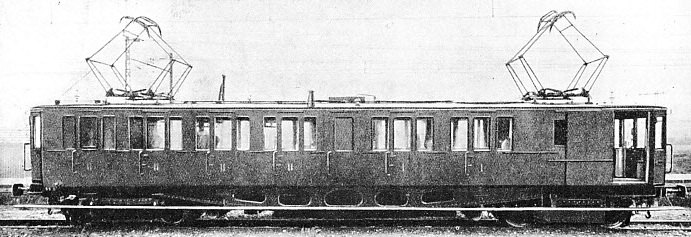
ON THE MIDI RAILWAY of France. This electrically-driven motor coach is equipped with special camshaft control equipment. The Midi Railway was among the first lines in France to adopt electrification. It is now amalgamated with the Paris-Orleans line.
The Marquet Plan, which came into force in 1934, marks the biggest step forward in the electrification programme yet taken. The largest item to be completed before 1934 relates to the Paris-Orleans and Midi Railways. In addition to the continuation of electrification on the local sections of the Midi Railway the plan envisages the electrification of the line from Tours to Bordeaux. The second largest scheme on which work has now begun is on the Etat line from the Gare Montparnasse in Paris to Versailles, Chartres, and Le Mans, a distance of 131 miles. Power is to be taken from Paris and from the Massif Central. The Marquet Plan, which includes also a short electrification scheme from Paris to Chateau Thierry on the Est Lines, is important for several reasons. It envisages the electrification of over 800 route miles. It is being undertaken in a period of acute depression, and can be said to be a striking proof of the favourable economic consequences of railway electrification work, particularly in its effect on unemployment. Last, and most important of all, electrification of the Etat main line to Le Mans shows that the schemes of the Paris-Orleans-Midi Lines have justified themselves from the point of view of railway efficiency. Since the Etat Line can purchase coal more cheaply than the southern lines, the governing reasons are not the cheapness of power supply, but the ability of electrified railway systems to increase traffic and to provide better services at lower operating costs per ton/kilometre.
The latest electrified section of the Paris-Orleans Railway, which came into operation in May, 1935, is the line from Orleans to Brive-la-Gaillarde, in the direction of Toulouse. This double track line is 186 miles in length, and is fed from the Eguzon power station at 90 kV to twelve sub-stations, where power is converted to the standard voltage of 1,500 DC. The line has a number of steep gradients, 1 in 100 being frequently encountered.
The locomotives is use are of the same type as those which have been at work on the Paris-Orleans system for some years. The heaviest and fastest trains are hauled by 2-Do-2 locomotives of 3,700-4,000 hp fitted with individual axle drive, and the ordinary passenger and goods trains by Bo-Bo locomotives of 1,400-1,700 hp with nose-suspended motors. This wheel formula is explained in the chapters “Some German Achievements” and “Electric Locomotive Classification - 2”. Certain stopping trains will be worked by 1,100 hp motor-coaches of the type used for the Paris suburban services.
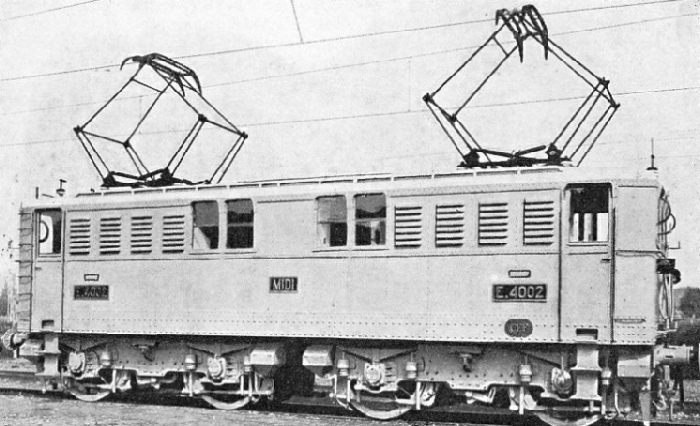
AN ELECTRIC LOCOMOTIVE on the Midi Railway of France. This locomotive is fitted with four 350 hp motors, which can be used as generators on down grades, to provide regenerative braking, by returning current to the supply line.
In Spain electrification has been mainly of a local character, although recently the Norte Railway has begun a scheme of main-line electrification from Madrid northwards. An important section of line electrified is that in the Asturias coal mining region. During the war, when coal production was at its height, the total load of coal which the railway system could handle was 5,800 tons. The capacity and the number of steam trains could not be increased without reconstruction of the permanent way, which was too costly to be considered. With electric traction, which came into operation in 1930, 6,500 gross tons were handled in one day. The speed of the trains hauled by a single locomotive was twice that of trains hitherto hauled by two steam engines.
In Poland an important suburban scheme around Warsaw was begun in 1934, while the construction of a new railway running about a hundred miles south-west of Warsaw was started. This railway is to be entirely electric. The Polish Government is considering a large number of other electrification schemes, notably one from Cracow to the Czechoslovakian frontier at Zakopotane. Incidentally, the scheme for the electrification of the Warsaw lines is being carried out by two British manufacturing companies, who are also reporting on other schemes for the Polish Government.
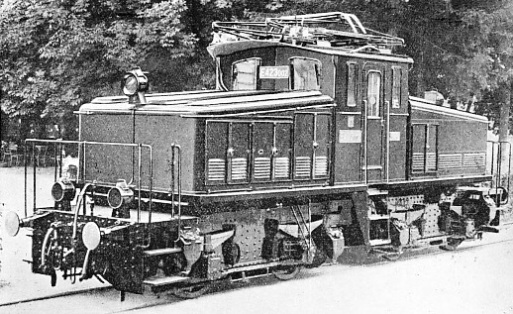
A 1,000 HORSE-POWER ELECTRIC SHUNTING LOCOMOTIVE which is in operation on the Czechoslovakian State Railways. There are about thirty miles of route electrified in Czechoslovakia.
Since the war the rise of the electrical manufacturing industry in Great Britain has been remarkable, and no field of activity illustrates this achievement better than does railway electrification. In the British Dominions, of course, it was to be expected that British manufacturers would carry out the extensive schemes put into operation in South Africa, Australia, and India. In South America and Japan British workmanship has played a far larger part than that of any other country. In Europe, the home of some of Britain’s most important rivals in the electrical manufacturing field - Germany and Switz-erland - British enterprise has had a share in work in Hungary, Spain, Denmark, France, Sweden, Czechslovakia, Holland, and Italy.
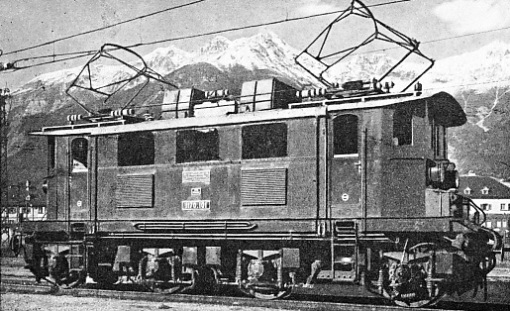
IN AUSTRIA. A powerful Austrian electric passenger locomotive which has a double-bogie arrangement. The Austrian Federal Railways own some 220 electric locomotives. The country has a large number of its lines electrified.
The Hungarian electrification from Budapest to the Austrian frontier at Heygeshalom is designed on the Kando system, according to which three-phase locomotives are operated from a single-phase supply line. The trolley wire is fed with 16,000 volt single-phase current tapped from the State three-phase transmission line, which supplies energy for industrial as well as traction purposes; and this is at the standard frequency of 50 cycles. The whole railway line of 118 miles is served by four sub-stations equipped with transformers connected on the high-tension side directly to the main transmission line from Banhida.
Because the electric locomotive or motor-coach train takes its power from a central power station, there is always a surplus of power available to provide a high rate of acceleration up to top speed. This is one of the cardinal advantages of electric traction, and it applies in full force to suburban traction. An electric train can normally complete a short journey, stopping at every station, in no greater time than a non-stopping steam train.
The fact that the electric locomotive draws its power from a central source is also responsible for the capacity of the electric locomotive to maintain speeds with heavy loads up steep gradients. It is this aspect of electric traction which has resulted in the conversion from steam to electricity on many of the European main lines. On the Swiss Federal Railway system, for instance, it was found in 1932 that the average haul of a steam train on certain sections of a line was limited to 132 tons, while, at faster running schedules, the average haul of an electric train was 310 tons.
On the Chambery-Modane section of the PLM, thirty-seven electric locomotives handle a heavier traffic than seventy steam locomotives. Europe, however, has nothing yet so striking to show from the combined point of view of haulage power and speed as the USA. On the newly electrified sections of the Pennsylvania Railroad locomotives are now in operation which can, if necessary, haul an 875-tons train for long distances at 90 miles an hour.
The question of speed is coming more and more into prominence. It is claimed that over long journeys, with steep gradients and heavy trains, electric traction is unrivalled for high-speed working. The high speeds obtained in Germany on experimental runs are detailed in the chapter “Some German Achievements”.
Swiss and German Feats
Recent tests with a streamlined electric motor-coach train on the Swiss Federal Railways between Brugg and Baden produced an average speed of 81 mph, 68·3 mph being maintained up a gradient of 1 in 83. Acceleration rates of 1·65 ft per sec per sec, and deceleration rates of 3·25 ft per sec per sec were recorded. Probably the record for fast electrical working is maintained at present on the Paris-Orleans line between Paris and Tours, there being heavy gradients between Orleans and Tours. Some details are to be found in the chapter “Speed Trains of Europe”. A standard recently set in Germany for a new class of high-speed locomotives embodies the capacity to haul a 450-tons train at 47 mph up a gradient of 1 in 40. Professor Reichel has recently stated that speeds up to 100 mph could easily be maintained by electric locomotives over long distances, but at present there is no commercial demand for such speeds. At present no electric services are worked at start-to-stop speeds greatly exceeding 60 mph, and normal maximum speeds, even on the fastest electric services, as yet rarely exceed 75 mph.
In the interesting prophecy to which reference was made at the beginning of this chapter, Professor Reichel allows for average speeds of 100-105 mph for ultra-fast trains on the journey between Berlin and Rome, for 75 mph for express trains, and for 56 mph for goods trains; but obviously nothing approaching such speeds would be possible over the sinuous and steep gradients through the Alps. Thus many factors other than traction equipment must be taken into account when assessing the possible speeds of the future, though there is little doubt that present timings are susceptible of considerable improvement.
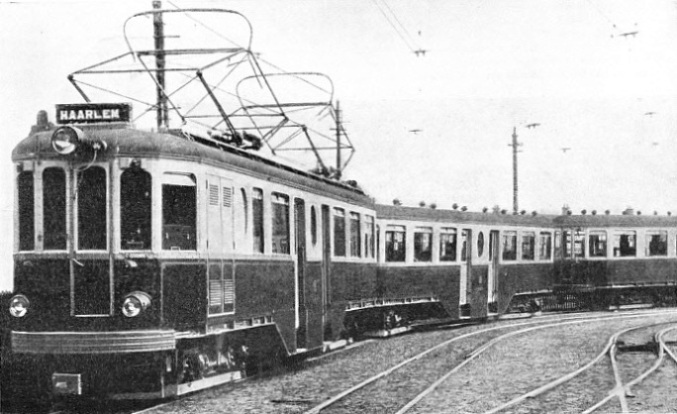
AN ELECTRIC MOTOR-COACH TRAIN on the Noord-Zuid Railway of Holland. This coach is equipped with three separate electric motors of 125 hp, 90 hp, and 56 hp respectively. The electrified Dutch railways linking Rotterdam, Amsterdam, and The Hague handle a high percentage of the total rail traffic in Holland.
You can read more on “Electric Locomotive Classification - 2”, “Electric Traction”, “Electrification Overseas” and “South African Electrification” on this website.















